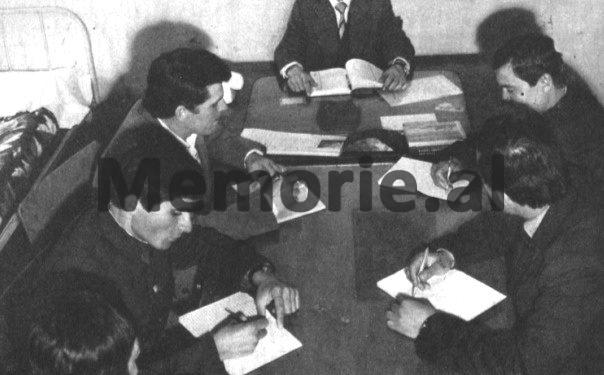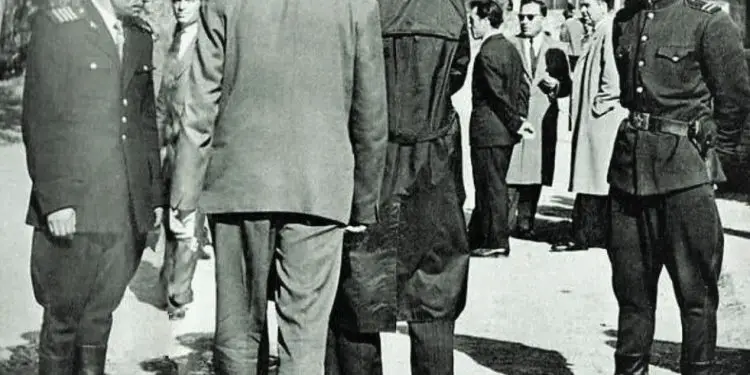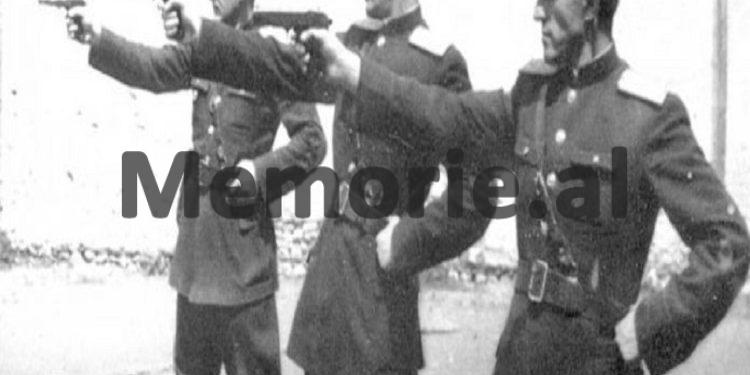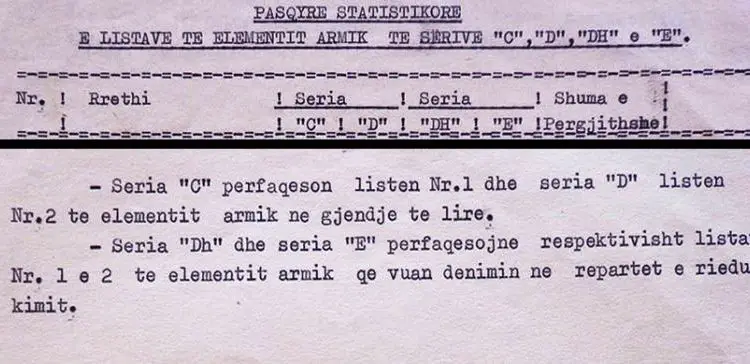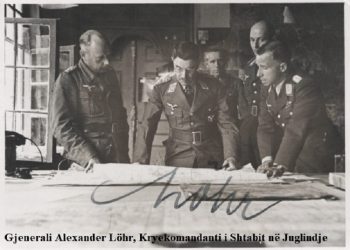By Kastriot Dervishi
Memorie.al/ After Enver Hoxha’s communist regime was consolidated in power, in the 1960s it began to develop the idea of creating blacklists against dangerous elements. In case of invasion of Albania, by any other country, the persons who made up these lists were executed. The lists that after 1992 were known as “death lists” were compiled on the basis of the register of active processing 2/A and operational controls 2/B. The opposing elements were selected by the Operative Workers, who were no longer familiar with the final form of the list. The directive “On the functions and duties of the bodies and departments of the Ministry of Internal Affairs during wartime”, approved by the Defense Council of the People’s Republic of Albania, served as the first basis, where the actions against the opponents of the regime were supported.
Based on order no. 507, dated 7.4.1969 of the Minister of Internal Affairs; “On the functions and tasks of the bodies and departments of the Ministry of Internal Affairs, in wartime”, the Operational Workers were not allowed to know, with the measures and readiness, to clear the areas from “dangerous enemy elements”, but they were allowed to participate, in the study of “enemy persons”, to designate in the relevant lists the objects they follow and have in evidence.
The lists were kept in one copy only by the head of the Department of Internal Affairs, in the readiness file and as such, were not reflected in other documents. Each Branch President opened the codified wartime envelope and ordered the liquidation of the opposing element, within the district where he had jurisdiction.
The category of persons included in list no. 1 was executed. Those on list no. 2 were exiled or imprisoned in special places, with the intention of using them as prisoners of war. In addition to the number, the lists also had identifying letters. The reference to the act of not understanding something was made in the following form:
-Series “C”, list 1, “enemy element in free state”
– Series “D”, list 2, “enemy element in free state”
– “DH” series, list 1, “enemy element” in camps and prisons
– “E” series, list 2, “enemy element” in camps and prisons
At the beginning of the 60s, it was estimated to be executed immediately in case of invasion of Albania, about 1 thousand people and about 3-4 thousand, in a state of freedom, would be imprisoned.
Of the camps and prisons, Burreli and Spaçi occupied the largest place. The districts leading the list were: Tirana, Shkodra, Korça, Elbasani, Vlora, Fieri, Dibra.
Based on the directives for the actions of the bodies of the Ministry of Internal Affairs in wartime, the Minister of Internal Affairs issued orders and instructions for the persons who had to be included in lists no. 1, no. 2 and no. 3. Referring to the order no. 01-699, dated 14.7.1972 and that no. 120, dated 8.5.1980, “On the meaning, categorization and evidence of the enemy element, with marked social danger, during war”, the following principles were defined:
– “Enemy elements with pronounced social danger”, were considered those persons who in the past and at that moment, developed “sharp hostile activities”, as well as members of their families, who were judged to present, in an exceptional situation, activation risk.
– “Acute hostile activity”, considered: espionage, terror, diversion, participation in criminal organizations, anti-party groups, conspiracies, military coups, etc. The study of “determining the enemy element with significant social danger” was considered; “action with a deep political character”, in accordance with the APS line. The study and categorization was done by the chairman, deputy chairman, head of the general sector, head of the Security section and Operative Worker. In the end, they were given to the first secretary of the District ALP Committee for his opinion.
The registration in the lists was made in two copies and was sent to the First Directorate of State Security, which prepared the practice, for approval by the minister. After approval, one copy was sent to the Department of Internal Affairs, while the other was kept by the department in question.
The list was worked on continuously, additions were made or names were removed, according to the same procedure. The categorization of lists no. 1 and no. 2, in camps and prisons, was done by the chairman, deputy chairman of the Department of Internal Affairs and the Operative of the country where the sentence was served.
List No. 1 consisted of:
Declassified elements, former feudal lords, beylers, agallars, bajraktars, big merchants, factory owners, etc.
-Senior officers of the time of Bird and War.
– Cadre of the secret services.
-Wartime agents.
-Directors of the organizations of the National Front, Legality, Social Democrats (Musine Kokalari), “Group of Deputies”, “Technical-intellectual Group”, “Albanian Union”, “Mountain Committee”, “Resistance Front”, “Vorio Silos- Epirot”, as well as members of their families.
-Framework of foreign discoveries.
– Repatriates who had gone through discovery courses and schools.
-American, Soviet, English, Italian, Greek, Yugoslav intelligence agents, etc.
– The anti-party element and members of their families (e.g. Liri Belishova, Pandi Kristo, Koço Tashko, Todi Lubonja, etc.)
– “Enemy element”, in processing for sharp hostile activity for espionage, terror, diversion, organization, etc., when this was proven.
-Political convicts, with high risk.
(From the upper groups, those who had helped the War or remained indifferent during it, but maintained a good attitude after the war, were excluded)
List no. 2 consisted of:
-Members of families that “betrayed the motherland” and served as active cadres of enemy intelligence.
-Family members of the fugitives, who had acted as “saboteurs”.
-Elements that had sheltered and helped “saboteurs”.
– All the convicts, for crimes against the state, without hostile activity.
-Family members of people shot for political reasons.
– Those convicted of crimes against the state, but also others of a lesser degree.
List no. 3 consisted of:
– Convicted persons who were not included in lists no. 1 and no. 2
To mask the correspondence, list no. 1 was called “C”, list no. 2 was called “D”. For the “enemy element, in camps and prisons for lists 1, 2, 3, the disguise “DH”, “E”, “F” was used.
Actions with lists no. 1 and no. 2 were expected to take place at night. The time needed to carry out arrests at the area, neighborhood, and city and district level was calculated, as well as the way of securing and escorting the categorized elements from the place of arrest, to the center of the area, to the general center of the district, anticipating the variant with vehicles and on foot.
For their implementation, operative groups would operate for the capture, escort and security of the “enemy element”, based on areas, neighborhoods and small towns.
On the basis of the directive, “On the functions and duties of the armed forces of the Ministry of Internal Affairs during wartime”, the Minister of Internal Affairs issued the instruction instruction no. 01-38, dated 22.11.1982, “On the clearance of the area in the situation war, from enemy elements with significant danger”, according to which, in case of armed aggression from abroad, the order for action with lists no. 1 and no. 2, is given in writing, only by the minister with the approval of the Defense Council. When that was impossible, the order was transmitted in cipher.
Upon receiving the order, the head of the Department of Internal Affairs (or the deputy when he was absent) opened the special envelope and followed the implementation of the orders. Operative workers of the State Security were the first responsible for the arrests, having physical knowledge of the elements in question, who took them to the designated place of concentration.
The following instruction “On the method of action of the head of the internal affairs branch upon receiving the order through the state code for the clearing of the area in a war situation from enemy elements with significant danger”, defined the method of action. The Minister appeared under the pseudonym “Erzeni 444”, while the Head of the Branch, “Shkumbini 555”.
The order that came to the head of the Department of Internal Affairs, from the minister in writing, or by telegram, was a slogan with a meaning understood before. Here are the cases of slogans:
-“The satellite came out of the cosmos”. As soon as the head of the branch received this, he took the measures for the execution of the persons who were part of the list no.1.
“The space rocket was destroyed.” It was given in cases where the execution of list no. 1 was done.
-“The test was successful”. It was the slogan with which the head of the Department of Internal Affairs informed the minister about the end of his duties./Memorie.al




